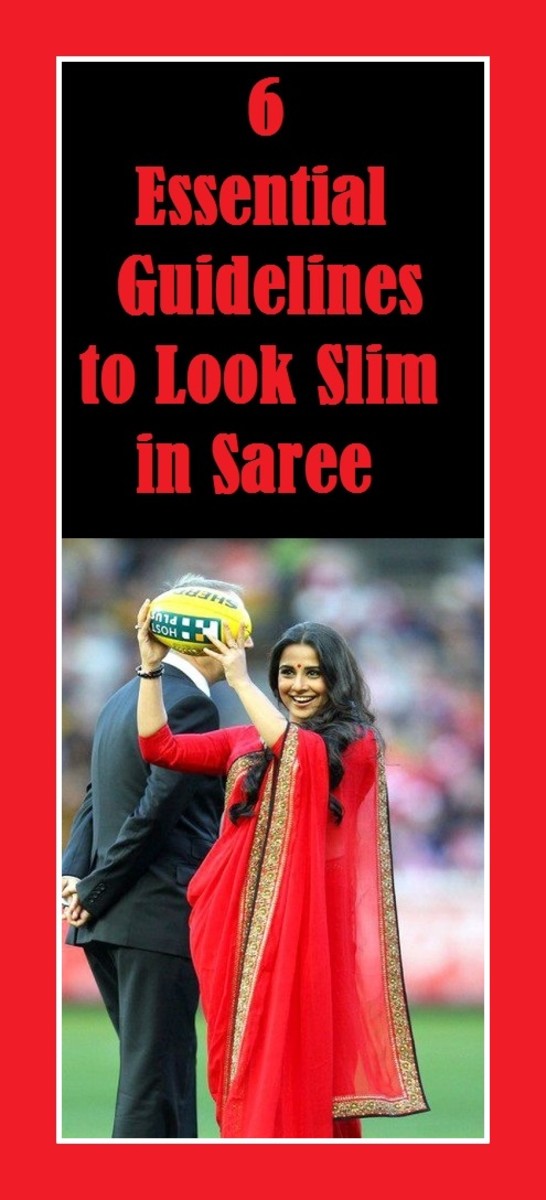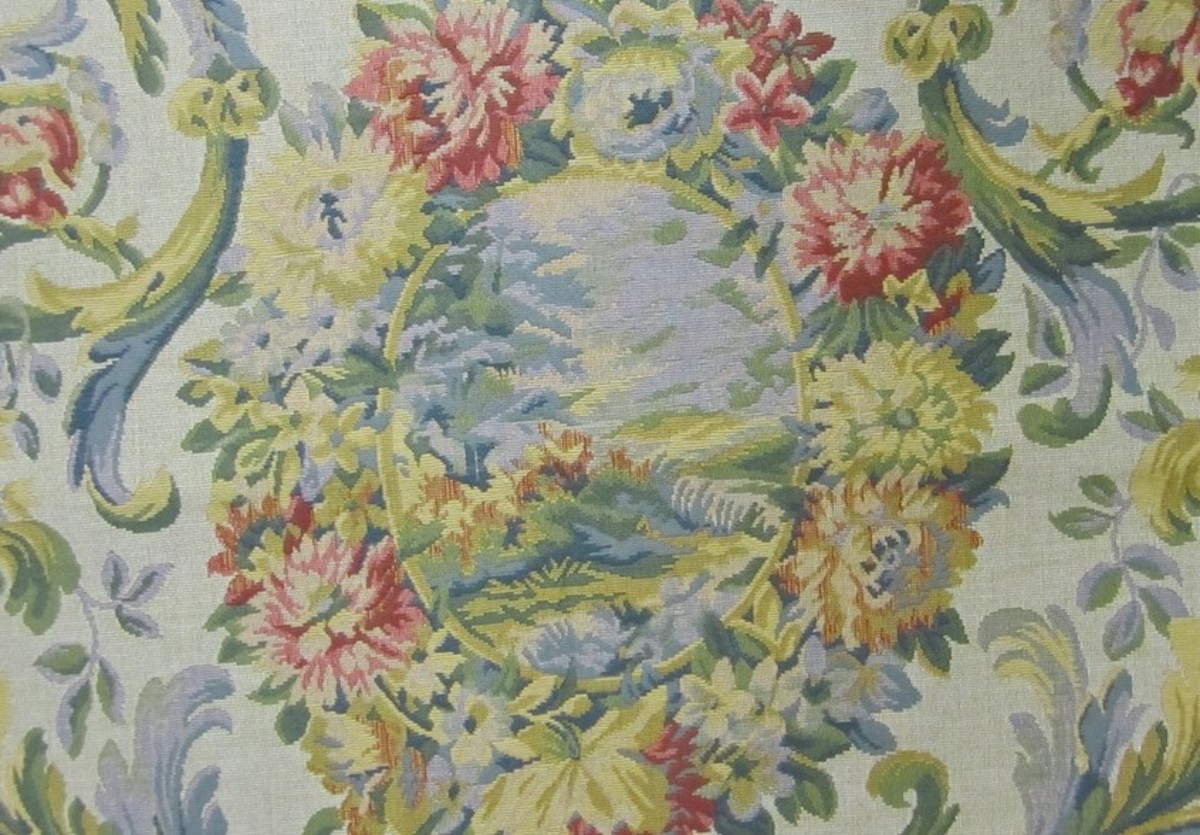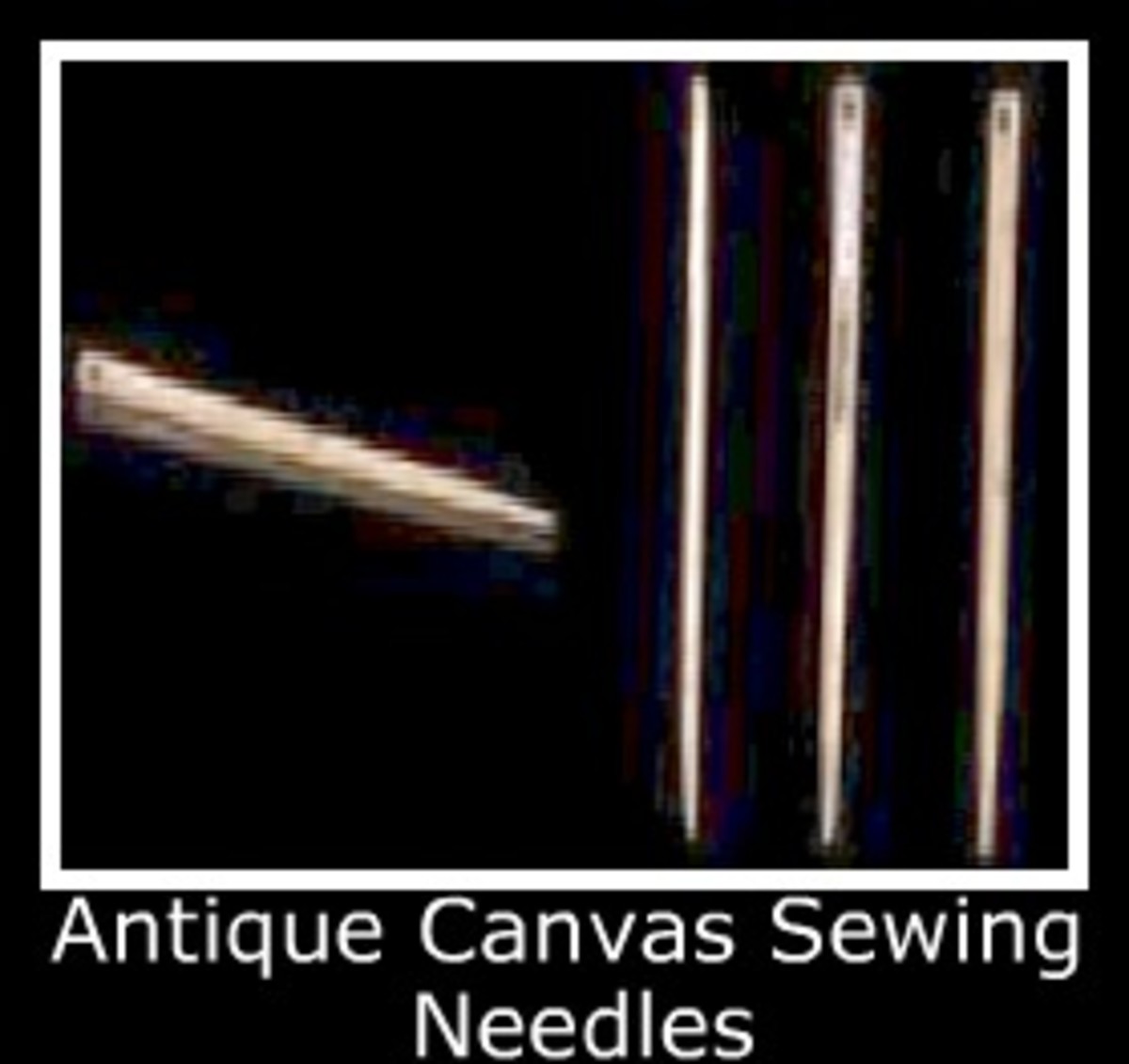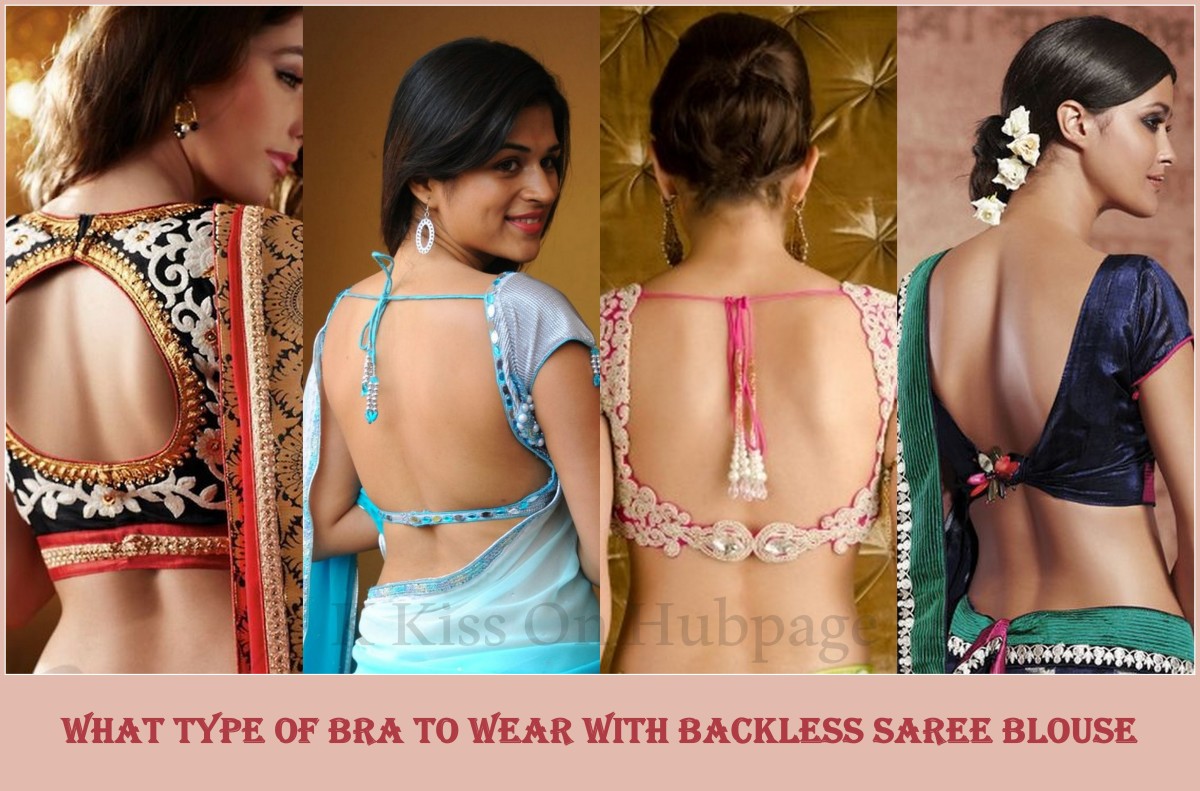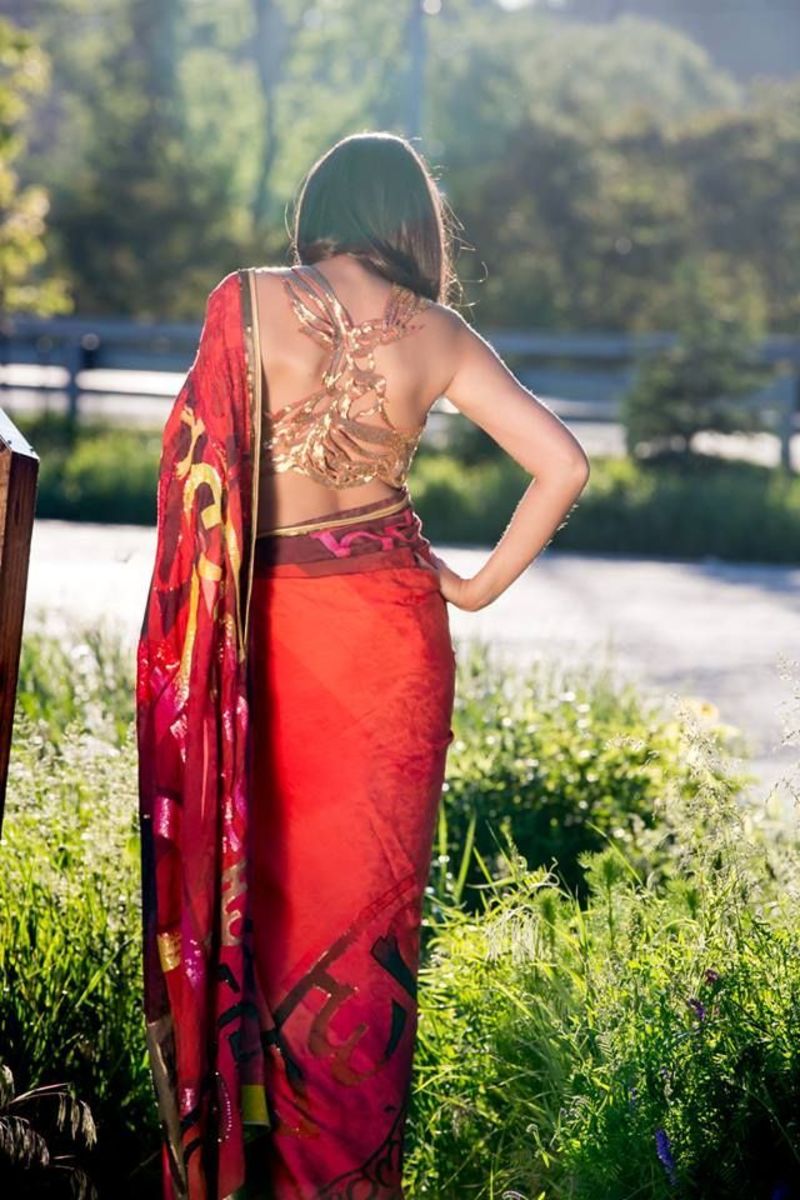Know Everything about Sarees and its Variety with pictures

What you dont know about Sarees?
History Of Sarees
Saris origins are obscure, in part because there are so few historical records in India. Yet, we know that Indians were wearing unsewn lengths of cloth draped around their bodies long before tailored cloths arrived.
This elaborate body-hugging style represented in the terracotta may have evolved among India's temple dancers in ancient times to allow their limbs freedom of movement while at the same time maintaining their standards of modesty.
There are many sculptures of Graeco-Indian Gandharan civilization which show a variety of different Sari draping styles. Tailored clothes arrived in India with the arrival of Muslims. Hindus beleived that any cloth pierced by needles was impure. It is commonly beleived in India that today's petticoat or "Ghagra" and the blouse or "Choli" which are worn under the Sari are later additions which started with the coming of British in India. Increasing number of upper class women in the early 20th century did adopt items of European style clothing as the fitted blouse and slim petticoat. This was also adopted due to the fashion of transparent chiffon Saris during that particular period. Some of the wives of Indian Kings draped themselves in Saris that were made by Parisian designers.
The concept of beauty in ancient India was that of small waist and large bust and hips, as is evident in the sculptures of those times. And Sari seemed to be the perfect dress to flaunt those proportions as it exposes the waist of a woman and emphasises the waist and bust with the pleated fabric. Sometimes women wore accesories like girdle (a belt) with elaborate design around their waist to emphasize the hip area.
Tips before selecting a saree
Saris origins are obscure, in part because there are so few historical records in India. Yet, we know that Indians were wearing unsewn lengths of cloth draped around their bodies long before tailored cloths arrived.
This elaborate body-hugging style represented in the terracotta may have evolved among India's temple dancers in ancient times to allow their limbs freedom of movement while at the same time maintaining their standards of modesty.
There are many sculptures of Graeco-Indian Gandharan civilization which show a variety of different Sari draping styles. Tailored clothes arrived in India with the arrival of Muslims. Hindus beleived that any cloth pierced by needles was impure. It is commonly beleived in India that today's petticoat or "Ghagra" and the blouse or "Choli" which are worn under the Sari are later additions which started with the coming of British in India. Increasing number of upper class women in the early 20th century did adopt items of European style clothing as the fitted blouse and slim petticoat. This was also adopted due to the fashion of transparent chiffon Saris during that particular period. Some of the wives of Indian Kings draped themselves in Saris that were made by Parisian designers.
The concept of beauty in ancient India was that of small waist and large bust and hips, as is evident in the sculptures of those times. And Sari seemed to be the perfect dress to flaunt those proportions as it exposes the waist of a woman and emphasises the waist and bust with the pleated fabric. Sometimes women wore accesories like girdle (a belt) with elaborate design around their waist to emphasize the hip area.
Tips to know before wearing Sarees
It is an undeniable fact that the sari adds to the elegance and mystery that surrounds a woman and gives her personality a new dimension. However, today more and more young women are shunning the sari for more "comfortable', less cumbersome' and manageable clothes. Even though, most of the people who are of the opinion that the sari is rather difficult to manage have no doubts about its versatility. According to Poonam, "I love wearing saris but unlike trousers which I can just slip on and off in a jiffy, wearing a sari means an extra half hour. But, I do agree that this apparel is an epitome of grace and beauty,"A sari lends itself beautifully to project the very best (in terms of physical appearance) in all women irrespective of her dimensions. In fact, the versatility of the sari is best brought about by the following lines." The sari's radiance, vigor and variety, produced by single straight length of cloth, should give us in the West pause and make us think twice about the zipper, the dart and the shoulder pad." The possibilities of a sari as a garment are tremendous and here are two concrete facts to support it. Firstly, several books have been written about the different ways in which a sari can be worn. One example of a rather popular book on the subject is "Saris: An Illustrated Guide to the Indian Art of Draping which is written and illustratred by Chantal Boulanger." The second fact is - `Sensual Saree Wearing,' a VCD from Fourth Dimension. It features demonstrations accompanied by voice-over of 18 different styles of wearing the saree plus 10 additional variations of the same. Designer Nita Lulla has been quoted as saying, No mini skirt and no bikini top can portray what a sari can." Nita points out,"No matter which country you belong to, a sari never fails to bring out your inner beauty, a fantastic feminine side that every woman has." Shaina N.C a designer of repute is one of the pioneers in the field of rediscovering the magic and versatility of the sari by using creative and innovative methods of draping it in several different ways. Well, if you are one of those people who cannot think of wearing a sari with trousers then, its time to think again. Shaina, whose forte is innovative draping of saris manipulates the pallu (also known as aanchal) in several ways to give the sari a new silhouette each time. Since the pallu is one of the most visible part of the sari., on should use every trick in their box to best display an embellished pallu. Another area that can be played around with is the pleats. The double sari, which is in actual fact two different kinds of garments, which are worn as one, is a product of her creative genius. "Instead of spending money on ghaghras, (which is normally put back safely in the cupboard) investing in two saris will be worthwhile as the saris can be worn on other occasions too," says Shaina. Some tips form experts in the field that will help you wear your sari perfectly:
· Avoid wearing a petticoat that is loose or dragging. Ideally, get your petticoats stitched to size.
· Make sure that your cotton sari is adequately starched and well ironed. When draping the sari remember to press down the pleats with your hand to keep the sari form flaring out.
Choosing the right accessories is the best way of enhancing your looks. The main reason for this is that your choice of accessory reflects your personality.
Hence, choosing the right accessory is as important as choosing you're the right clothes.
In the case of saris your accessories would include blouses in addition to jewellery, shoes, bags and bindis. Most designers suggest that that it is not a bad idea to experiment with the different kinds of blouses that are in fashion. The good old low back blouse is one thing that never goes out of fashion.
However, the important thing is that the blouse should be well fitted. Coming to shoes. The right shoe with any outfit is one that is comfortable. Matching the colour of your shoes to your outfit is a good idea. Having neutral colour shoes in your wardrobe is an excellent idea as these colours go with almost any kind of sari. Another thing to keep in mind is the occasion. Weddings and other such occasions demand that you wear shoes that are as grand as your outfit. But, a party in the evening would require you to wear something more elegant. Now we come to jewellery. This is an age old passion as far as women are concerned. The thing to remember here is that jewellery is worn to complement your looks and to overshadow your personality. Therefore,choose jewellery that complements not only your looks but also your style. Daytime jewellery needs to be light-thus pearls, stones and light gold and silver jewellery is a good idea. Jewellery worn in the evening can be heavy and bright. Last but not the least bags have come in a big way as not just beautiful but also useful accessories. What makes choosing bags a much easier affair than anything else is their names as they are classified party bags,evening bags, shopping bags etc. All this information will help you turn a million heads wherever you go. So, head for your wardrobe.
Major types of sarees that are produced in the different regions of India:
Pochampally sarees
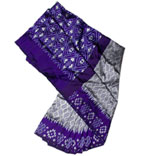
Pochampally sarees
: The famous Pochampally sarees are woven in the small cluster of villages around Hyderabad in Andhrapradesh. This cluster includes the villages of Pochampally, Koyalagudam, Puttapakka, Elanki and Chautupal. The tradition of weaving these sarees in these villages has been passed on from one generation to another. These sarees are usually woven from pure silk. The silk used in these sarees is brought from Bangalore while the jari or the golden thread is brought from Surat. Motifs such as elephants, flowers, parrots and diamonds are traditionally used in these sarees. The weavers are, however, developing new designs, keeping in view the changing trends and the preferences of the customers.
: The famous Pochampally sarees are woven in the small cluster of villages around Hyderabad in Andhrapradesh. This cluster includes the villages of Pochampally, Koyalagudam, Puttapakka, Elanki and Chautupal. The tradition of weaving these sarees in these villages has been passed on from one generation to another. These sarees are usually woven from pure silk. The silk used in these sarees is brought from Bangalore while the jari or the golden thread is brought from Surat. Motifs such as elephants, flowers, parrots and diamonds are traditionally used in these sarees. The weavers are, however, developing new designs, keeping in view the changing trends and the preferences of the customers.
Ikat Sarees
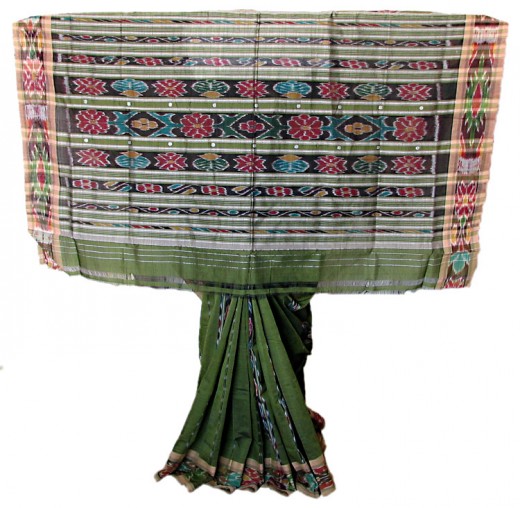
Ikat sarees: These sarees are woven in Orissa. They are very much similar to the Pochampally sarees of Andhra Pradesh.
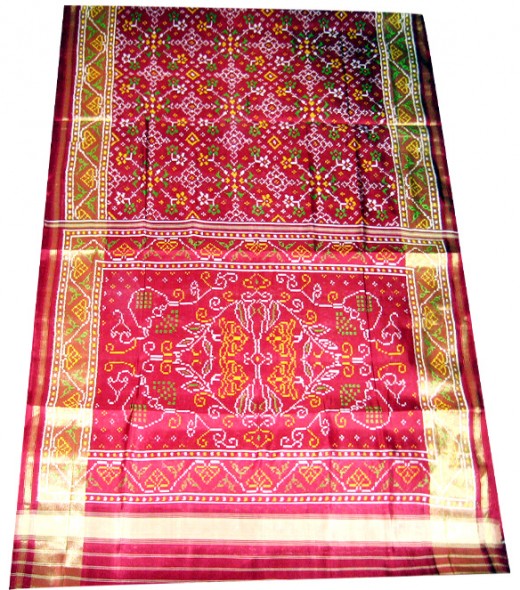
Patola sarees: The famous Patola sarees are manufactured in Patan in Gujarat. They are also very much similar in design to the Pochampally sarees.
Garhwal sarees: The town of Garhwal near Hyderabad is famous for the production of Garhwal sarees. These sarees are known for their attractive borders, which are woven using silk threads. The sarees are usually woven from pure cotton, silk or a combination of cotton and silk. These sarees are also called ‘Kupadam' and ‘Kumbam' sarees.
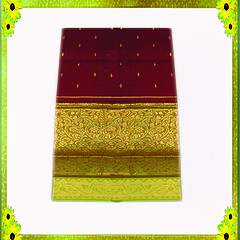
Venkatagiri sarees: The Venkatagiri sarees woven in the state of Andhra Pradesh are quite popular. These sarees are usually made of cotton. Traditional motifs such as flowers, animals and birds are woven into these sarees using a combination of silk thread and cotton thread.
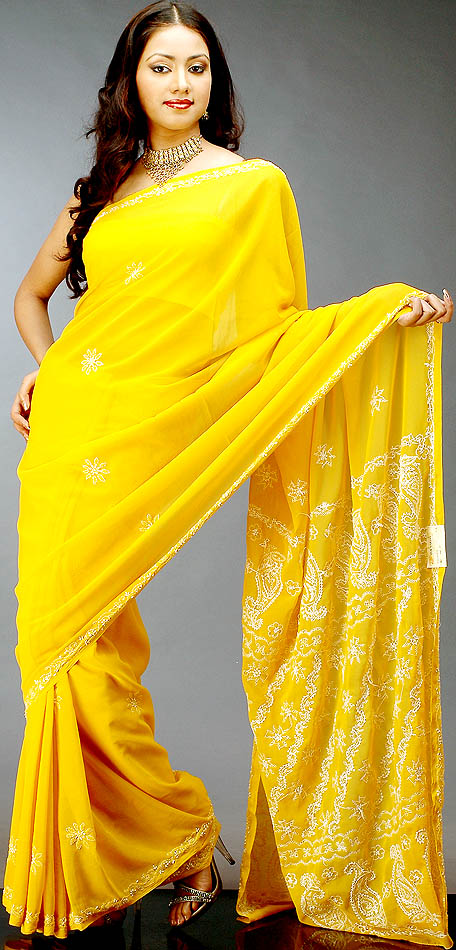
Chikan sarees: Chikan embroidered sarees produced in Lucknow are very famous all over India and even internationally. In this type of embroidery that is commonly known as Chikankari, different effects can be created using different types of thread and stitches. Initially, Chikan embroidery was done using white thread on muslin cloth that is opaque. However, in modern times, Chikankari is done using threads of different colors. Synthetic fabrics are also being used. Keeping in view the latest fashion trends, sequins and other decorative items are being used in Chikan sarees to give them a trendy look.
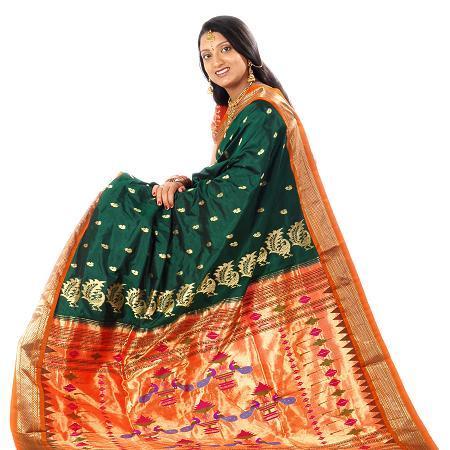
Paithani sarees: The Paithani saree is a saree woven in silk in the Paithan region in Maharastra. These sarees usually have a plain or spotted body and a heavy golden border and pallu. Sometimes threads of two different colors are used in weaving the saree to create a special effect. Paithani sarees are generally available in traditional colors such as red, green, sky blue, magenta, purple, yellow and pink. The silk thread used in the production of these sarees is brought in from Bangalore.
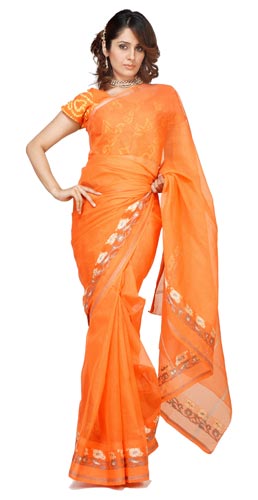
Kota sarees:Kota sarees are sarees which are produced in Kota, Rajasthan. These sarees are also called ‘Kota Doria'. Initially, these sarees used to be produced in pure cotton, but now they are also prepared using synthetic yarn. The unique feature of a Kota saree is the checks formed in the saree while weaving. These checks are formed either using golden thread or ordinary thread. Usually, these sarees are manufactured in bright colors such as orange, yellow, red, blue, purple and green.
Calcutti sarees: Calcutta specializes in the production of pure cotton sarees. These sarees, popularly called Calcutti sarees, are famous all over India and even in other markets.
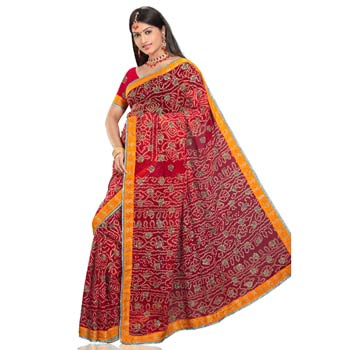
Bandhni sarees: Bandhni sarees are sarees that are produced mainly in the states of Gujarat and Rajasthan. They are also called ‘Bandhej' sarees. These sarees are produced using the art of ‘tie and dye'. Bandhej work is generally undertaken on silk and cotton cloth. Mostly, natural and bright colors are used in these sarees. Tie and dye is carried out to form different patterns. The ‘Gharchola' is a type of tie and dye saree produced in Gujarat and Rajasthan. This saree is traditionally used as a wedding saree.
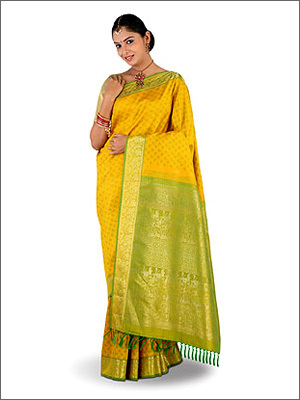
Kanchipuram sarees: The Kanchipuram saree is a pure silk saree produced in the temple town of Kanchipuram in South India. The silk used in these sarees is manufactured in Karnataka, while the golden thread or jari used is brought from Surat. The best known patterns in Kanchipuram sarees are ‘Mayilkann' (peacock's eye), ‘Kuyilkann' (nightingale's eye), ‘Rudraksham' (Rudraksha beads) and ‘Gopuram' (temples). The designs in these sarees are generally inspired by nature and by the temples in the region. In an original Kanchipuram saree, the saree and the pallu are woven separately and are then stitched together.
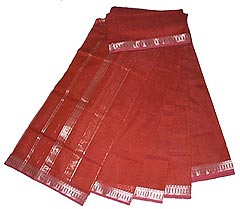
Maheshwari sarees: The Maheshwari sarees are one of the types of sarees that are popular all over India and even internationally. These sarees were originally designed for the family and friends of Queen Ahilyabai Holkar, who ruled Indore in the state of Madhya Pradesh. The designs in these sarees were originally inspired by the designs on the walls of the Fort of Maheshwar. However, the patterns and colors used in these sarees are changing nowadays, keeping in view the changing trends.
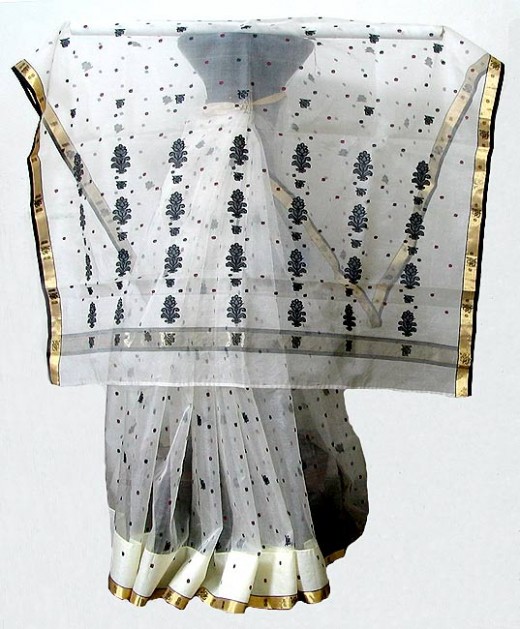
Chanderi sarees: Chanderi sarees are produced in a smalltown called Chanderi in the state of Madhya Pradesh. They are woven using a combination of silk and cotton threads. These sarees usually have a thick golden border. The designs used in these sarees are based on hunting scenes, trees, men, women, birds, fruits, flowers and heavenly bodies. Generally, subtle colors are used in these sarees. Sometimes these sarees have golden buttis or golden checks all over the body.
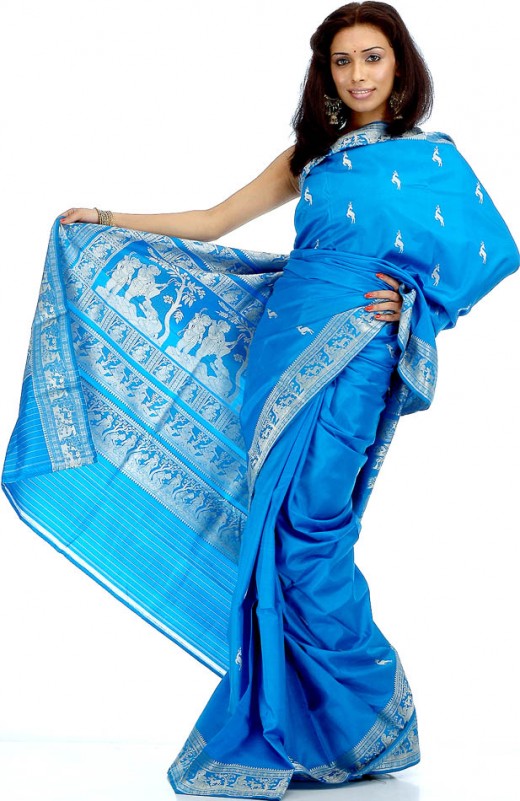
Baluchari saree: The famous Baluchari sarees are produced in Baluchar in West Bengal. These sarees are made of figured silk, with designs brocaded on them. Typically, motifs of large flowers and shrubs are used in these sarees. Sometimes Indian mythological scenes are also patterned on these sarees
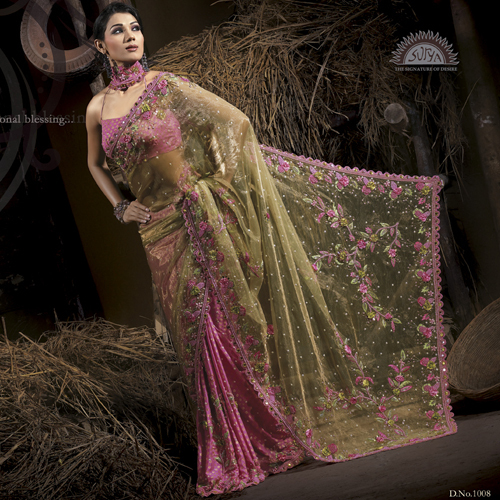
Tanchoi sarees: Tanchoi sarees are produced in Surat in the state of Gujarat. Figures of birds, trees and flowers are commonly used in these sarees. Sometimes, the pallu is richly decorated with large figures of peacocks, flower baskets and hunting scenes. These sarees are made from a special fabric called Tanchoi, which is woven using a distinctive technique. This technique is a combination of the Indian and Chinese styles of weaving.
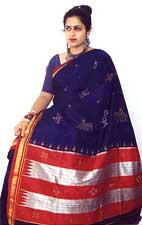
Ilkal sarees: The Ilkal saree is woven in the town Ilkal in Karnataka. Kasuti embroidery is done on these sarees, which is a special form of embroidery done in Karnataka. This type of embroidery is highly intricate. The typical embroidery patterns used in Ilkal sarees are chariots, lotuses, elephants, lamps, conch shells, palanquins, etc. This type of embroidery is done without knots so that both the sides of the fabric look the same. Ilkal sarees measure 9 yards in length. The end regions of the pallu are cut in different shapes. The colors that are traditionally used in these sarees are pomegranate red, parrot green and peacock blue. Bridal wear Ilkal sarees are made in a special color which is called ‘Giri Kumkum' in that region. The red-colored pallu is a distinguishing feature of Ilkal sarees. Jamdani sarees: Jamdani sarees are woven in Bangladesh. These sarees are made from a special type of cloth called Jamdani. This cloth is woven using a special technique, which is a combination of Bengali and Middle Eastern weaving techniques. In these sarees, patterns are woven using the same colored thread as the base cloth. Sometimes, gold and silver threads are also used for weaving patterns.
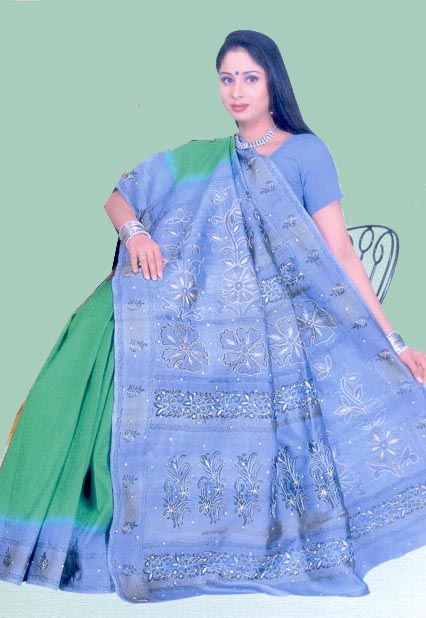
Mysore silk sarees:Mysore silk sarees are sarees that are made from a special type of silk that is produced in Mysore, Karnataka. These sarees are very light in weight and have a unique shine to them. In spite of being delicate, these sarees are highly durable. Mysore silk is one of the purest forms of silk
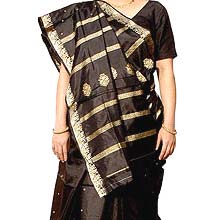
Banarasi silk sarees: The silk sarees produced in Banaras, popularly known as Banarasi silk sarees, are famous the world over. In the city of Banaras, four types of sarees are mainly produced, i.e. pure silk sarees, the Shattir saree, the georgette saree and the organza saree. The pure silk Banarasi saree is the most famous of these. Sometimes, pure gold and silver threads are made use of in these sarees.
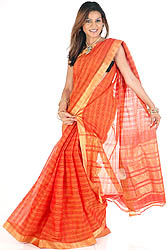
Mangalgiri sarees: Mangalgiri is a town located near Vijaywada in Andhra Pradesh. This town is famous for its sarees, which are popularly known as Mangalgiri sarees. Usually, these sarees have a golden border and are made from pure cotton. Mangalgiri is also famous for its cotton dress materials.

